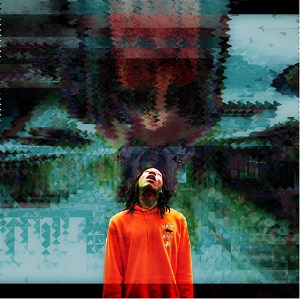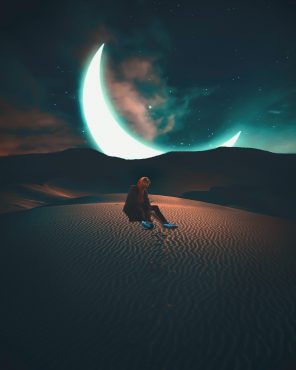
The cover for “Onomatopoeia”
Allston Pudding: Why don’t you tell us a bit about yourself?
THELASTGEKKO: My name is THELASTGEKKO, formerly known as Kenyah Browne. I am a musician and multimedia artist from Boston. I was born and raised in Hyde Park — near the skate park, actually. That’s one of the most defining parts of Hyde Park. It’s a pretty small area, not much else is really going on there. It’s kinda swampy too now that I remember it. Brighton is more where I’ve been around. It’s really, really populated. I like it.
AP: You’ve been working on a new EP that’s coming out soon, Visions Before.
TLG: Yeah. I’ve been actually working on a bigger project, too. I’ll keep it unnamed for now. But this is kind of the culmination of working on a vision and seeing that I want to build on it as I go along. So this EP’s kind of like a first preview feature.
AP: How long have you been working on music?
TLG: Four years, seriously. I started coming out of high school, and it was more of a hobby, more something that I didn’t know what I wanted to do [with it]. But as I got into doing it over my actual work in college, I enjoyed it a lot more and found that it was my real passion. From there, it was more along the lines of me taking my knowledge from doing music in high school and before and bringing it into the “now” moment. I just kind of worked from there. FL Studio, live music as well, and then putting everything together.
AP: This has been a pretty prolific year for you, having released an album in the first half of the year. Can you tell us about that?
TLG: That album was the first project I really wanted to show people. It kind of has a blend of what I do singing-wise and what I also do production-wise, as well as my main focus of… I don’t want to call it just “rap,” so it’s “hip-hop.” I like to really deliver and give good lyrics.
AP: Can you describe your intended vibe for that album?
TLG: I really want to reach people who want to listen to introspective music, but at the same time, are just open to all types of vibes. I don’t like to define it in a way that it’s trap or inclined to a certain vibe, but I’d really like it to be introspective, so the listener actually feels something from the music. I’m really into trip-hop, that’s my biggest influence. Massive Attack is one of my favorite artists. Once I found out they made [the theme song to] House, I realized why I liked House so much. I’m really inspired by Madlib and a lot of other producers. Since I produce my own music, that’s what really drives me.

AP: Do you also play all the instruments for your tracks?
TLG: Yeah. I do the arranging, and I mainly play the piano. I used to play drums, but now I play bass and guitar. All my drums are through a drum machine, and then I just put that into my program.
AP: Do you work on creating and editing your own samples?
TLG: Yeah, I do. I’ve learned how to play instruments live and then record them and do the process of actually sampling. I rarely sample anymore nowadays, because sampling from one of my favorite video games or from one of my favorite movies…I’ll do that for something to listen to, but I won’t necessarily try to take a sound from it. Not that I necessarily don’t like it; it’s just not my favorite way to make music. Final Fantasy has beautiful music and is my favorite game series. Final Fantasy Tactics and FFX are equal to me. “Someday the Dream Will End,” I love that song. The notes in that song and how they progress…maybe like cutting a quick sample of that into something before a song comes on… I think that would give a song a great mood.
AP: You definitely utilize interesting, non-typical chord progressions for hip-hop. How do you go about writing those?
TLG: I arrange my music myself. I don’t read music great anymore. I kind of do it just because I have to do it, just because I’ve been training myself to over time. But I mainly play by ear, so I will build from a scale that I started, find a nice chord, find a progression that I’m really interested in, figure out whatever key it’s in, change it how I want and build it from there. I build it mainly on my piano, though. Piano’s the backbone of my music.
AP: You describe yourself as an “independent, adaptable artist.” Can you speak more to that?
TLG: For me, from the beginning, I was always having to work by myself. Collaboration is a big part of art, so when I do work with other people, I find that at the end of the day, they’re either feeling what I’m making or liking what I’m trying to go towards with the end goal, but don’t really want to put the work into it for what I’m seeing with my vision. So I kind of learned how to do it all by myself, and I was able to work on video parts or work on the music, whether it’s mixing or producing, or whether it’s editing or directing and composing a video. I would have to go through all processes of the art and be able to be flexible, whether it was working [on my projects] before or after work, just to get my stuff done. It made me really appreciate the process.
AP: You’ve directed a few of your own videos, like “Don’t Call.” How do you approach the cross between visuals and music?
TLG: I think it’s major, because I think sound is spatial. You can see it visually, and that’s my goal: to represent that through my music. The crossroads of it is kind of difficult because you have to come up with the ideas and be flexible with yourself. I keep a journal just so I can write down any idea that comes across my mind, because sometimes I’ll be sitting there editing my video, and a verse will come to me about something. It’s the process of going through that work again. Sometimes I’ll be producing [music], and a video idea will come from the sounds that I’m making. It’s really intertwined at the end of the day.
AP: How’d you shoot that video?
TLG: My guy, Robert Costa, or Bobhatescomputers, he’s like, one of the best guys ever. He tinkers a lot. He has his own drone, and he helped me out with the footage. We shot that in one day.
AP: That video, as well as the video for “Stimulate,” are similar, both using a color-tinting effect. What do you think that brings to the videos?
TLG: It’s something that I fell in love with immediately. I’m not very well-versed in my video editing skills yet, but I still work to it every day, but color changing is one of the biggest things that I found that can give emotion to a video. That’s something that I’m trying to refine as I proceed through it because even the most popular videos nowadays have some sort of color changing. I’m trying to bring people in an artistic space, where they can just feel the music and feel the video itself.
AP: How often do you perform live currently?
TLG: It’s been a really good year so far. I want to say I’ve performed live over 50 times this year, around that. It’s been about one to three times a month. Mostly around Boston, but I’ve had one show in Rhode Island and one in New York.
AP: Do you bring that visual side of it to your live performance?
TLG: When I can, or when I get to link up with any of the projectionists that I work with. That usually consists of any art pieces that they’ve made and I do a choreography to their art piece.
AP: For the new EP, you’ve already released two singles so far, each with a video. The next is “Onomatopoeia.” Do you have plans to release a video for that?
TLG: I’m trying to build a following for it. I’m still trying to figure out how I want to do it, because I haven’t shot a video for it yet. The EP is going to be seven songs total. I’m still debating on “Onomatopoeia” just to see if there’s a want for it, but honestly, I love that song so much, I feel really good about it.
AP: Compared to the tracks on [PHLVLS], the newer songs sound like you’ve been able to refine your production skills. How quickly have you been able to pick those up?
TLG: I feel like it’s been exponential this year alone, because of the consistency. I say I’ve been working on music for four years solidly, but it’s been a very scattered process. I went through a lot in the first two years of my time working on music, from being homeless to having to move multiple times, so I lost a lot of work and equipment. But this year that I’ve been working on music, so far, has been the most profound in the sense that I had a place solidly I could go to and store my music and continually build a catalog. That’s what’s helped me refine and get my sound to where I want it to be.
AP: Do you find you’ll work on something for a little while, then put it on the back-burner, then come back to it with a better idea of how to complete it?
TLG: That’s exactly how my process goes, but I don’t call it the “back-burner.” I don’t call it anything. I just keep it to the side, because my workstation is kind of messy, but everything is organized-chaos. One section is for stuff that I’m going to get back to, but before I play the piano; or that section’s where I’m going to get back to but before I start editing video. I consistently keep myself working on something so I can get the idea for the next thing and move through it and keep the creative process flowing.
AP: You’ve added a little more bravado to your lyrics. They seem less introspective compared to the nighttime tunes of [PHLVLS]. What’s prompted that change?
TLG: I kind of made it for myself, because the album was supposed to be this grandiose idea, but eventually I was like, I’m keeping myself in a box. I did that to show myself that I could make something.
I feel like they can reach people as well, and they can relate.
AP: What are your goals moving into 2018?
TLG: To reach a larger audience. I mean literally finding people all around the world, not just in the United States or just in Europe. I want to find people who actually want to listen to new music. People who go to a concert and actually want to find out who that person is. And if I can get into contact with a business manager or something.
AP: Given the consistent tone of [PHLVLS], do you write lyrics with a set narrative in mind?
TLG: Yeah! There is a certain narrative in my head when I’m writing from that perspective. Maybe that’s even the reason I named myself “Gekko.” I want to call it, like, almost a suffering or a struggle, but just something that you’re having to fight against in your development. There’s always an antagonist to it. A lot of the time, I find it’s the internal struggle of the protagonist being his own antagonist. Writing from that perspective gives it a very personal urgency. It’s dire. The words come out that way. They have weight to them. When things feel urgent, when things feel like they’re life-or-death, the words that come out feel a lot more erudite, meaningful, rather than just “let’s have a party, let’s drink, let’s do some stupid shit.” I did that on “Stimulate,” just to play with the words a bit.
AP: Can you speak more about the narrative of [PHLVLS]?
TLG: It’s a story about the main character realizing there’s something wrong with him. There’s something wrong with the way he interacts with other people, and he’s not sure of why it always ends in something going wrong. It starts with him interacting with his girlfriend and not understanding what the problem is. It leads to them breaking up. From that point, he goes through layers of himself to understand what he did wrong, to understand how his interactions with other people usually off-puts them. It ends with the reconciliation of learning what he did wrong, expressing it to his girl, and them having a conversation. “PH” stands for “Prince Harming,” but I turned it into this idea of balancing out yourself. There are two mindsets with how you think about yourself. “I’m right in this or denying and not wanting to communicate and express.” And also, in hindsight, how love will make you feel after something is removed or away from you for a long time. Taking the idea of duality and breaking it down to a point where you realize there is no duality.

AP: Can you explain the meaning behind the name THELASTGEKKO?
TLG: First, the name Gekko came about just because I love lizards. I love how they’re social, but also antisocial. They’re loose creatures. But I also found that in the space of music, there are more than 100,000 geckos. There are tons of geckos! Initially, I was kind of wondering how I could stand out from that, but eventually, it came to me that I’d be the last one that ever existed because my shit’s going to matter. My shit’s going to actually stay here and be something. Also, I was told at a certain point that I looked like a gecko, so it just stuck.
AP: Who are some other geckos in music?
TLG: A lot in Spanish hip-hop. I’m not familiar with their music; I just looked them up on Soundcloud or Spotify. A lot of them in folk, too. I don’t know why.
AP: Visions Before drops January 19th?
TLG: Yes. I should have videos done for everything by then. That’s what I’m going to spend the month of December working on, but I have a big surprise for when I drop Visions Before. A visual project. I’m going to be planning a release show for the EP sometime around when it drops.
You can listen to “Onomatopoeia” below.
